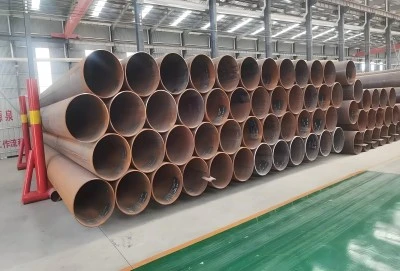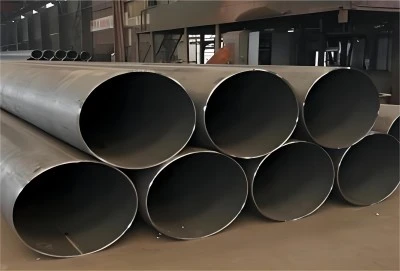When it comes to pipeline infrastructure, particularly in the oil and gas industry, the API 5L X60 pipe stands out as a crucial component. One of the most significant aspects of these pipes is their wall thickness, which plays a vital role in determining their performance, durability, and safety. In this comprehensive guide, we'll delve into the intricacies of API 5L X60 pipe wall thickness, exploring how it's measured, the factors that influence it, and why it's so critical in various applications.
|
|
|
How is the wall thickness of API 5L X60 pipe measured?
Measuring the wall thickness of API 5L X60 pipes is a precise and critical process that ensures the pipes meet the stringent standards set by the American Petroleum Institute (API). Here's a detailed look at the measurement techniques and tools used:
1.Ultrasonic Testing
One of the most common and non-destructive methods for measuring pipe wall thickness is ultrasonic testing. This technique uses high-frequency sound waves to determine the thickness of the pipe wall. Here's how it works:
- A transducer sends ultrasonic waves through the pipe wall
- The waves bounce back from the inner surface of the pipe
- The time taken for the waves to return is measured
- This time is converted into a distance, giving the wall thickness
Ultrasonic testing is prized for its accuracy and ability to measure thickness without damaging the pipe. It's particularly useful for in-service inspections, as it can be performed without interrupting pipeline operations.
2.Micrometer Measurement
For more direct measurements, especially during manufacturing or in laboratory settings, micrometers are often used. These precision instruments can measure wall thickness with extreme accuracy, often to within 0.001 inches. The process involves:
- Placing the pipe section between the micrometer's anvil and spindle
- Carefully closing the micrometer until it contacts both sides of the pipe wall
- Reading the measurement from the micrometer's scale or digital display
While highly accurate, this method is typically used for spot-checks or quality control rather than for measuring entire pipe lengths.
3.Radiographic Testing
Radiographic testing, or X-ray inspection, is another non-destructive method used to measure wall thickness. This technique involves:
- Exposing the pipe to X-rays or gamma rays
- Capturing the resulting image on film or a digital detector
- Analyzing the image to determine wall thickness based on the density of the material
This method is particularly useful for detecting internal flaws or variations in wall thickness that might not be apparent from the outside.
4.Laser Measurement
Advanced laser measurement techniques are increasingly being used in the pipe manufacturing industry. These systems use laser beams to measure the outer diameter and inner diameter of the pipe simultaneously, from which the wall thickness can be calculated. Laser measurement offers:
- High-speed measurement capabilities
- Exceptional accuracy
- The ability to measure continuously along the length of the pipe
By employing these various measurement techniques, manufacturers and inspectors can ensure that API 5L X60 pipes meet the required wall thickness specifications, contributing to the overall quality and reliability of the pipeline infrastructure.
What factors affect the wall thickness of X60 pipes?
The wall thickness of API 5L X60 pipes is not arbitrarily determined but is influenced by a variety of factors. Understanding these factors is crucial for engineers, manufacturers, and end-users to ensure the pipes meet the required specifications and perform optimally in their intended applications. Let's explore the key factors that affect the wall thickness of X60 pipes:
1.Design Pressure
One of the most significant factors influencing wall thickness is the design pressure of the pipeline system. Higher operating pressures require thicker pipe walls to withstand the internal stresses. The relationship between pressure and wall thickness is governed by the following factors:
- Hoop stress: The circumferential stress in the pipe wall due to internal pressure
- Safety factor: A multiplier applied to ensure the pipe can withstand pressures beyond normal operating conditions
- Material yield strength: The maximum stress the pipe material can withstand without permanent deformation
Engineers use these factors in conjunction with established formulas to calculate the minimum required wall thickness for a given design pressure.
2.Environmental Conditions
The environment in which the pipe will be installed and operated plays a crucial role in determining its wall thickness. Factors include:
- Corrosive soils or fluids: May require additional wall thickness as a corrosion allowance
- Temperature fluctuations: Extreme temperatures can affect the material properties of the pipe, necessitating adjustments in wall thickness
- External loads: Such as soil pressure in buried pipelines or wave forces in offshore applications
These environmental considerations often lead to the specification of wall thicknesses beyond the minimum required for pressure containment alone.
3.Manufacturing Process
The method used to manufacture the pipe can influence its wall thickness. The two primary manufacturing processes for API 5L X60 pipes are:
- Seamless pipes: Created by piercing a solid steel billet, resulting in a more uniform wall thickness
- Welded pipes: Formed by rolling steel plate and welding the seam, which may result in slight variations in wall thickness around the circumference
Manufacturing tolerances also play a role, as there will always be slight variations in wall thickness along the length of the pipe.
4.Material Properties
The specific grade of steel used in X60 pipes influences the required wall thickness. Factors include:
- Yield strength: Higher strength allows for thinner walls while maintaining the same pressure rating
- Toughness: The ability to resist crack propagation, which may require thicker walls in certain applications
- Ductility: The material's ability to deform without fracturing, which can affect the safety factor used in thickness calculations
5.Regulatory Requirements
Various codes and standards, such as API 5L and ASME B31.3, provide guidelines for minimum wall thicknesses based on pipe diameter, material properties, and operating conditions. These regulations ensure safety and consistency across the industry.
6.Economic Considerations
While safety is paramount, economic factors also play a role in determining wall thickness. Thicker walls require more material, increasing costs. Engineers and project managers must balance safety requirements with economic feasibility when specifying pipe wall thicknesses.
By carefully considering these factors, pipeline designers and engineers can specify the optimal wall thickness for API 5L X60 pipes, ensuring both safety and efficiency in pipeline operations.
Why is wall thickness critical in API 5L X60 pipe applications?
The wall thickness of API 5L X60 pipes is not just a matter of specification; it's a critical factor that directly impacts the performance, safety, and longevity of pipeline systems. Understanding the importance of wall thickness helps stakeholders appreciate the meticulous engineering that goes into pipeline design and maintenance. Let's explore why wall thickness is so crucial in API 5L X60 pipe applications:
1.Pressure Containment
The primary function of any pipeline is to contain and transport fluids under pressure. Wall thickness plays a pivotal role in this regard:
- Hoop Stress Management: The wall thickness must be sufficient to withstand the hoop stress created by internal pressure without yielding or rupturing.
- Safety Margins: Adequate wall thickness provides a safety buffer against pressure spikes or accidental overpressurization.
- Long-term Performance: Proper wall thickness ensures the pipe can maintain its integrity over its designed lifespan, often decades, under continuous pressure.
2.Structural Integrity
Beyond pressure containment, wall thickness contributes significantly to the overall structural integrity of the pipeline:
- External Load Resistance: Thicker walls help pipes resist external loads from soil pressure, traffic loads (for buried pipes), or wave action (for offshore pipelines).
- Buckling Resistance: Adequate wall thickness prevents collapse or buckling under vacuum conditions or external pressure.
- Handling and Installation: Pipes with appropriate wall thickness can withstand the stresses of transportation, handling, and installation without damage.
3.Corrosion Allowance
In many applications, especially those involving corrosive fluids or environments, wall thickness includes a corrosion allowance:
- Extended Service Life: The extra thickness allows for gradual material loss due to corrosion without compromising the pipe's integrity.
- Maintenance Planning: Known corrosion rates and initial wall thicknesses help operators plan for inspections and replacements.
- Safety Buffer: The corrosion allowance provides an additional safety margin against unexpected or localized corrosion.
4.Welding and Joining
Wall thickness is a critical consideration in pipe joining processes:
- Heat Input Control: Thicker walls can absorb more heat during welding, reducing the risk of through-thickness thermal effects.
- Joint Strength: Proper wall thickness ensures that welded joints have sufficient material for full penetration welds, maintaining the strength of the pipeline.
- Fit-up and Alignment: Consistent wall thickness facilitates proper alignment during joining, reducing stress concentrations.
5.Economic Efficiency
While safety is paramount, wall thickness also has economic implications:
- Material Optimization: Specifying the correct wall thickness optimizes material usage, balancing cost with performance.
- Transport Efficiency: For fluid transportation, the internal diameter (affected by wall thickness) impacts flow rates and pumping efficiency.
- Lifecycle Costs: Proper wall thickness can reduce maintenance frequency and extend the operational life of the pipeline, improving long-term economics.
6.Regulatory Compliance
Wall thickness is often subject to regulatory requirements:
- Safety Standards: Compliance with industry standards like API 5L ensures that pipes meet minimum safety requirements.
- Environmental Protection: Adequate wall thickness is crucial for preventing leaks and spills, protecting the environment and meeting regulatory obligations.
- Quality Assurance: Strict wall thickness specifications are part of quality control processes, ensuring consistency and reliability across pipeline projects.
Contact Longma Group
In conclusion, the wall thickness of API 5L X60 pipes is a critical parameter that impacts every aspect of pipeline performance and safety. From pressure containment and structural integrity to corrosion resistance and economic efficiency, wall thickness plays a multifaceted role in ensuring the success of pipeline projects. As technology advances and new challenges emerge in the pipeline industry, the precise specification and measurement of wall thickness will continue to be a cornerstone of safe and efficient fluid transportation systems.
Understanding the nuances of API 5L X60 pipe wall thickness is crucial for anyone involved in pipeline design, construction, or maintenance. By appreciating the factors that influence wall thickness and its critical importance in various applications, stakeholders can make informed decisions that enhance safety, efficiency, and longevity in pipeline infrastructure.
For more information on API 5L X60 pipes and their specifications, please contact our experts at info@longma-group.com. We're here to help you find the right solutions for your pipeline needs.














